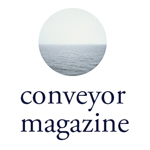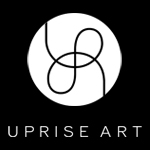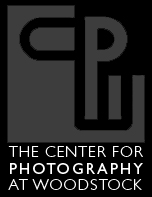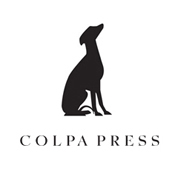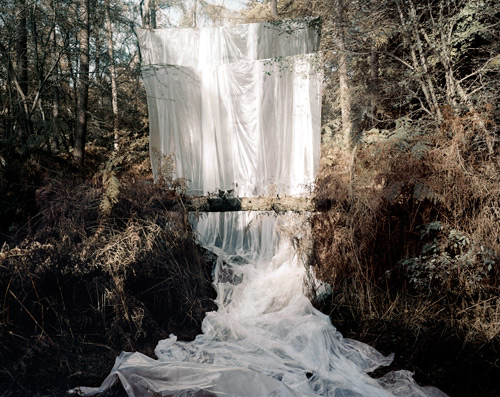
Noemie Goudal. Les Amants (Cascade), 2009.
The shifting space between reality and fantasy, nature and intervention, playfulness and tragedy, is where Noemie Goudal’s fantastical images live.
— Elizabeth Bick
For More Visit: { www.noemiegoudal.com }
Happenings: Pieter Hugo at Yossi Milo Gallery
Conveyor Editor-At-Large, Elizabeth Bick, explores Pieter Hugo’s seductive yet challenging work, Permanent Error, on display at Yossi Milo from September 8th through October 29th. Earlier this year, Prestel Press published a book of the work under the same title.
In his most recent project, Permanent Error, Pieter Hugo takes photographs of a technological wasteland that sits just outside of a small Ghanaian town called Agbogbloshie. The land is filled with digital debris of all kinds, including motherboards, cell phones, video games, and wiring. All of the technology is sent to Ghana broken or obsolete as a “donation” from companies and organizations in the United States and Europe.
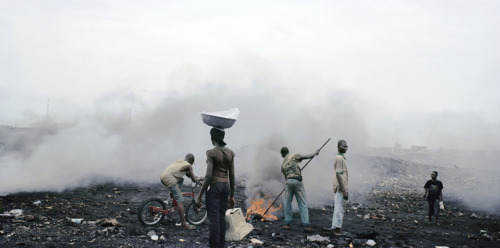
The depicted post-apocalyptic landscapes are inhabited by people who wander across the wasteland, sifting through mercury, PVC, and lead, looking for material to burn and sell as scrap. According to Frederica Angelucci, who wrote the essays for Hugo’s recent book on the project, “The area, on the outskirts of a slum known as Agbogbloshie, is referred to by local inhabitants as Sodom and Gomorrah, a vivid acknowledgment of the profound inhumanity of the place. When Hugo asked the inhabitants what they called the pit where the burning takes place, they repeatedly responded: ‘For this place, we have no name’.”
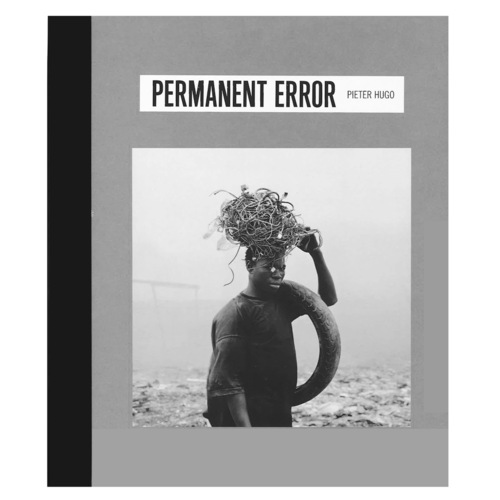
The exhibition of the work at Yossi Milo creates a visually charged window into another world. Typical of Hugo’s installations, life size or larger-scaled works sit in pristine white frames, dramatically contrasting the subject matter.
Standing before the series, it is difficult to fathom how exactly these images of inhumane living conditions fit into a gallery setting. The stunning photographs surface potentially unfamiliar environmental issues, yet, the works are being sold as commodities. We return to this question: is turning a painful situation into a set of aesthetically seductive photographs the most effective way to represent such a message to an audience? “There is no idyllic seasonal harvest in this vast dump of discarded technology,” Angelucci writes, “there is no chanting, no sign of festive gatherings at the end of a long day.” Likewise, perhaps there is no idyllic way to depict this wasteland.
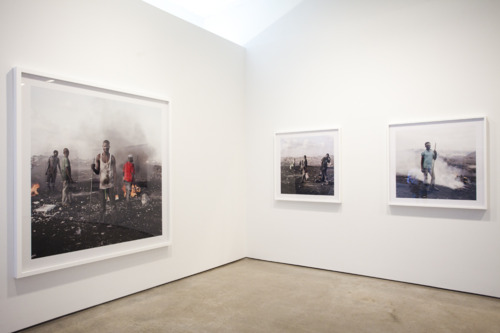

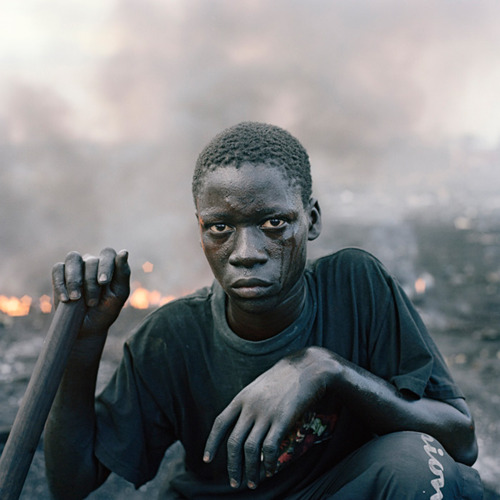
In the world of documentary photography and photojournalism, the jury is still out. Earlier this year, at the Photographic Universe Conference in New York City, photographer Andrea Geyer and professor Susie Linfield attempted to deconstruct the uncomfortable relationship between tragedy and representation. Click the links below to learn more about the conference and Geyer and Linfields discussion.
Click for Video Footage
http://photographicuniverse.parsons.edu/main
Interview with Penelope Umbrico
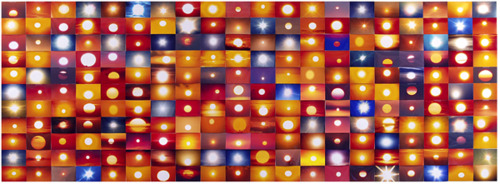
To kick off our interview series on the blog, we dug into our archives to bring you excerpts from an interview with Penelope Umbrico featured in the print version of Conveyor Magazine, Issue No 1.
In March, Penelope Umbrico invited Conveyor Magazine editors Christina Labey and Elizabeth Bick to her Downtown Brooklyn studio as a continuation of the conversations held at The Photographic Universe conference at Parsons, The New School. Penelope’s ideas resonated throughout the conference. The presentation of her work sparked dynamic conversations on the significance of the increasing global accessibility of Internet snapshot archives to photographic theory. In the following interview, we talk with Penelope about the future of her Suns from Flickr Project, the status of the appropriated digital image, and the investigation of a uniquely digital sublime.
CM: Your work embraces the overwhelming amounts of images on the Internet. Why did you choose, from everything out there, to focus on images of the sun?
PU: To begin with, I was simply struck by the amount of pictures of sunsets. I was thinking about the fact the sun is actually out there, so far away, warm and so on. What was interesting was how we take that thing [the sun] and subsume it to this electronic space. That to me was really poetic. I started to look at the images and think about how they are all the same, how I could comment on that sameness. Of course, we only have one sun but if millions of people are taking pictures of it, then we have millions of suns.
CM: If the sun is always there, why do we feel compelled to photograph it?
PU: Exactly, as if to own it. If there is an element of awe and worship toward the sun, is photographing it taking control of it? And what does it say that we all participate. Oddly the question of authorship gets tangled up here – it’s lovely and poetic to engage in an activity that virtually everyone does – and in the process make photographs that follow a very defined script. It’s another, entirely, to claim individuality or subjectivity with these photographs.

CM: The way the Suns from Flickr project has taken on this new dimension is fascinating. You are finding images all over the Internet of people posing for pictures in front of the sun installations, which lends itself to one of the concerns of your work: the proliferation of suns. Were you anticipating this?
PU: It took me by surprise that this was happening. I now have a collection of these images of people posing in front of my installations as though they are in front of an actual sunset. I am collecting the ones where the subject is looking straight into the camera and as I start showing these images alongside the installation, hopefully it will encourage more of these photographs.
…
CM: From the outside your practice seems very digitally based, however, sitting here in your studio I can see how much you respond to the tactile and physical nature of photography. You have stacks of photographs and work tacked up on all the walls. I think it’s really interesting how you still seem very committed to the tactile process of the printed photograph.
PU: At the conference, Tina Barney asked James Welling if he ever gets frustrated with the flatness of the two dimensionality of the photograph. I was surprised by the question – to me that flatness is seductive, and I love the physicality of the print. I like the work to sit right on the edge between representation and abstraction, illusory 3-dimensional and 2-dimensional object. So yes, I am very particular about material and craft. It’s important to me, for example, that the sun photographs are produced via a mass-market process – 4” x 6” Kodak “Easy Share” machine prints (Kodak actually calls them this) or that Broken Sets (eBay) are digital c-prints on metallic paper – the sheen and luminescence of that paper lends to the coolness of the subject matter (the technological breakdown derived from images of broken electronic displays sold on eBay).
…
Penelope Umbrico is featured in the show Social Media at the Pace Gallery Opening Tonight!
Social Media
The Pace Gallery
510 West 25th Street, New York
Thursday September 15, 6:00 - 8:00 pm
To see the rest of the interview in print { www.conveyormagazine.org }
To see more of Penelope Umbrico’s work: { www.penelopeumbrico.net }
15 Sep 2011 / 1 note / Penelope Umbrico Conveyor Magazine Christina Labey Elizabeth Bick Suns From Flickr
Words with Pictures
Words with Pictures is a weekly two-part post that pairs photographers and writers. The first week, a writer is given a photograph to inspire the creation of a new piece of writing. The following week the photographer is given a piece of writing and responds with a new photographic piece. This series is curated by Conveyor Editor Dominica Paige.
Leif Huron and Jane Flett {Part 2}
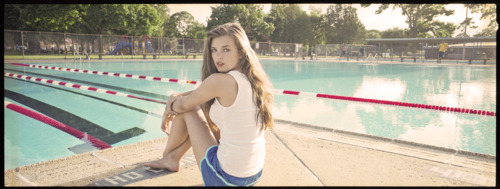
I bunked off today.
I closed the laptop lid and cooed, “Hush child, stay here; I promise I’ll return.”
The sun had already sucked the water from the marshland. All that was left was spittle and dandelion clocks, fragments of glass glittering like the mosaics of waterfalls.
A Hasidic Jew cycled by through the grass. It was strange to see him there, so far from town. He looked like a black paper doorway pasted onto a painting of summer.
I did not try to step through him.
I was busy counting the buttercups and the daisies and recording the tallies in a squared maths jotter. So far, the daisies were trouncing the buttercups seventy-nine to forty and it seemed the buttercups were losing faith, preparing themselves for the button-lipped disappointment of the car ride home.
I was holding out, however, even allowing a jaunty cirrus to distract me from a daisy clump or two: “Aloha, buddy! How’s the view up there?”
/
I have always had a thing for the underdog.
At the end of the marshes lay the octopus tree, beckoning for a hug with his open branches. There was nothing to do but clamber, scuff-kneed, into the boughs.
I found a nook to rest my cheek against and inhaled the smell of broken pencils. I knew I would be safe here from the protestations of the working week, from its spindly, tyrannous fingers.
I knew, if I wanted it, the afternoon was mine. I was free as a feather to play kiss chase with my brain.
Jane Flett lives in London where she writes stories, plays synthpunk cello solos and drinks too much gin. You can visit her at: {www.janeflett.com}
Leif Huron studied film direction and cinematography at the Academy of Film, Television and Performing Arts in Prague, CZ. His films and photographs have been featured as part of the American Photo 2008 Photos of the Year competition, Rush Arts Gallery Freeze Frame exhibition at Art Basel Miami, VUU Collective 2011 Group Show at K&K Gallery, and at Diagonale 2011 Film Festival, Graz, Austri, among others. He is currently a Candidate for MFA in Photography and Related Media at Parsons The New School for Design. Leif lives and works in Brooklyn. {www.leifhuron.com}
14 Sep 2011 / 1 note / Jane Flett Leif Huron Dominica Paige Words with Pictures
Field Notes: Emotional Cartography
Conveyor Editor, Chelsey Morell, speaks with artist Christian Nold and researcher Bryan Denny, to learn more about emotional mapping and how it could potentially be used to understand a place.
Along with a group of media artists, psychogeographers, and cultural researchers, artist and designer Christian Nold has developed a set of emotional road maps for cities around the globe—San Francisco, Greenwich, Westminster, Paris, Rio, among others—with the aim of creating a type of socially-engaged art he calls Emotional Cartography. These maps are conjured into existence with the help of a modified GPS/GSR monitor (for measuring global position and arousal) strapped to a group of about 80 willing wanderers. The device tracks their emotional reactions along each of their routes as they pass landmarks, ex-lovers’ houses, cafes, traffic signals, and seas of other people.

Embedded within these emotional maps a quiet dance takes place between the most minute and transitory of one’s inner life and the outer limits of our world. As Nold himself has pointed out, through these mapping exercises “the participants are linking together the personal and intimate with the outer space of satellites orbiting around the Earth.” Beyond these spacial feats, Nold is acutely aware of other crucial questions. “Can we really blend together our emotions and experiences to construct a totally shared vision of place?”
Recently, I caught up with Bryan Denny, a researcher in Columbia University’s Social Cognitive Affective Neuroscience (SCAN) Lab, to talk about some of the implications of Nold’s project from a scientific perspective. We spoke at length about where exactly Nold’s Emotional Cartography project sits. What borders does it cross between art and science? In what circumstances could this somewhat soft or subjective representation of data be helpful or revelatory. Although Denny believes that decoding the specifics of an individual’s brain response is more complex than Nold puts forth, he admits that it certainly would be useful, assuming we could disentangle the true emotional signal from the data’s noise. “Receiving information,” he says, “about our brain’s physiognomy in real time could provide us greater ability to control the arousal that we feel in a given situation. It might suggest which route to work is most stress-free, or in which restaurant one feels the least aroused—if this isn’t readily apparent experientially.”

For people with alexithymia, a condition that makes it difficult to express one’s psychological state, it does take that extra push in order to describe the emotions that might bubble up after passing an ex’s house or a stunning view. In this case, Nold’s GPS/GSR monitors may help them to identify and avoid or revisit these emotions and express them to others where they wouldn’t have been able to before.
Denny was generally excited about the prospects of seeing real-time brain responses outside of a lab setting, but he also expressed some concern about the darker side of emotion monitoring. “As our ability to infer psychological phenomena becomes more sophisticated,” he warns, “the importance of protecting ‘thought privacy’ will become more urgent.” Knowing which areas of Paris provoke the highest arousal might indeed be useful if you’re planning a romantic getaway, but, just as there are perks, there could be some equally awkward drawbacks if your jogging partner is able to see your brain activity spike as you pass a secret rendezvous point or that spot in the playground where someone beat you up in the 5th grade. Just think of all the trouble it would cause for someone like Don Draper.
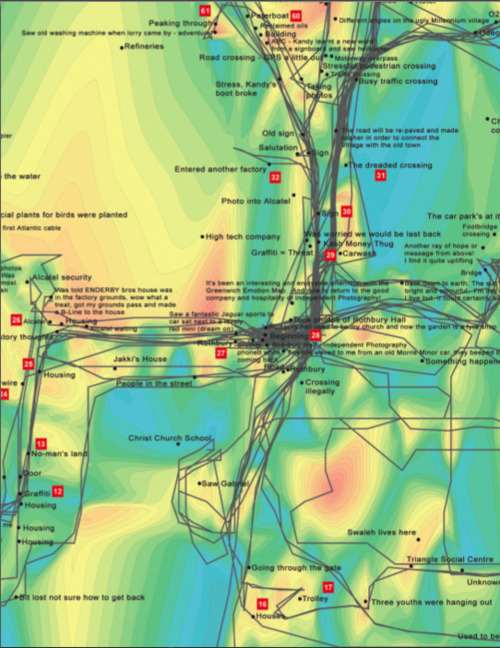
To see more about Emotional Cartography, or to buy an emotion map of one of the cities mentioned above, visit: http://emotionmap.net/map.htm
For more information on the SCAN Lab or to participate in one of their groundbreaking studies on emotion regulation, you can find them here: http://www.scan.psych.columbia.edu/home.html
13 Sep 2011 / 1 note / Field Notes Chelsey Morell Emotional Cartography Bryan Denny Christian Nold Maps
Open Call for Submissions for Issue No. 2 Themed “Mapping”

Last call for submissions for the Autumn 2011 Issue themed “Mapping”. We are seeking various interpretations of the theme including: literal representations of maps, traditional cartography, brain mapping, information mapping, exploration, geography, topologies, mapping the universe and more.
By submitting, your work will be considered for the “Group Show” segment of Conveyor Magazine, as well as for the accompanying exhibition, which will take place at 25CPW in Manhattan this November.
Deadline: Sunday, September 18, 2011.
No Fee For Submission!
Click to Submit
Photograph by Sophie Barbasch
Featured in Issue No 1. and accompanying exhibition Undressing The World.
13 Sep 2011 / 0 notes / Conveyor Magazine Submissions Sophie Barbasch
Project Series: Maria Sprowls
In the series Found Women, artist Maria Sprowls traces the ethereal social bonds that women maintain. Combining found photographs circa the early 20th century with feminine hued stitching, a second portrait emerges; one in which the fading image remains vibrant.
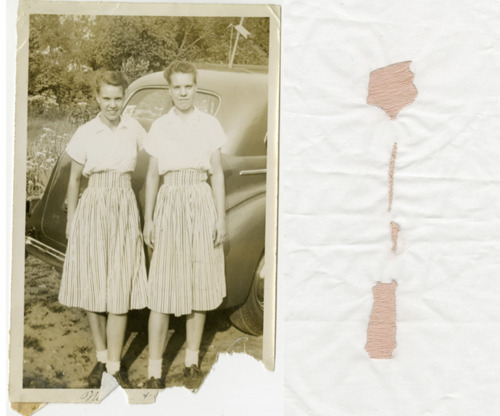
The distance or absence of a human body may make the space between each one of us appear devoid of content or physicality; however, Maria sees this space as a dwelling for memories of the past and the desire for the present. In this world, the sensitive and strong emotions of companionship and bonding become a delicate archipelago.
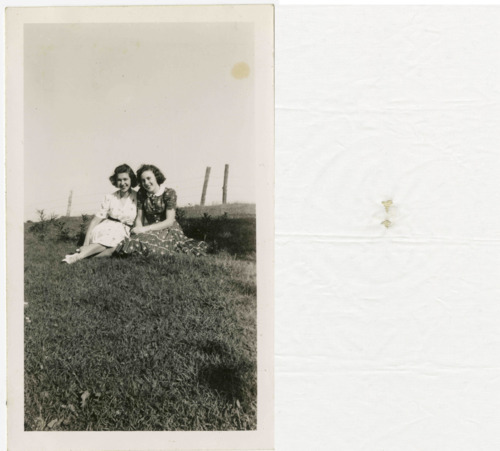

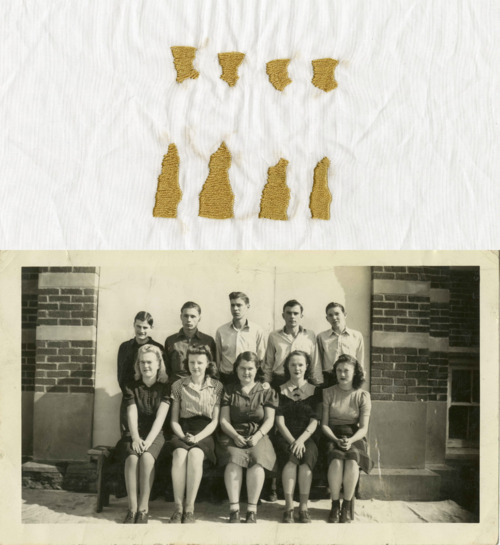
12 Sep 2011 / 2 notes / Found Photography Maps Sylvia Hardy Maria Sprowls Project Series
Happenings: CCNY’s 2011 Annual Juried Exhibition
Conveyor is excited to introduce a guest post by John Stanley, Director of the Camera Club of New York. Here he tells us a little bit about the 2011 Annual Juried Exhibition, which celebrates its closing reception tonight, September 9th from 6:00 - 8:00pm!
Tonight marks the closing of the annual Juried Exhibition at The Camera Club of New York. The show presents the top three finalists from the juried competition, including Nathan Bett, Goseong Choi and Hugo Fernandes. Guest juror Richard Renaldi chose the recipients from over 250 applicants who responded to an open call earlier this year.
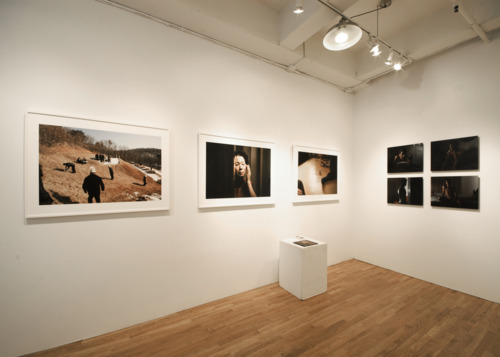
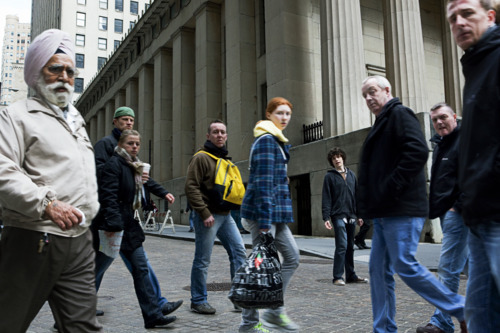
Nathan Bett, the first place winner, makes photographs of people on the street that reverses the roles of viewer and viewed. It was stunning to see his work in person, after only seeing low-resolution files on screen during the submission process. The large scale and clean, white mounting of the works, which Conveyor Arts printed and framed, transformed them. I can’t help but think about these detailed, crowded streetscapes, in which each figure stares at the viewer with such seriousness, as a commentary on contemporary life in New York City. Bett is a relative newcomer to the city, and, when asked if he could do this work outside of the city, he responded that he has tried but it just isn’t the same. New York City is full of cameras and likewise full of people who become very aware of a lens that has been aimed at them. His modern take on the classic street scene shows just how much the New Yorkers of today differ with those of the mid-twentieth century; they are still on the street, but they are very media conscious and quickly look back at the prying eye of the ever-present camera.

Goseong Choi, the second place winner, presents work from the series Umma, which examines the sense of loss that the artists’ mother felt when her mother passed away. And finally, third place winner Hugo Fernandes presents Intimate Strangers, a series that modifies two types of archetypal encounters, the photographic portrait session and internet-based sex hook-ups, and creates a shared contemplative act that suspends anonymous sex and replaces it with an ambiguous yet intimate exchange.
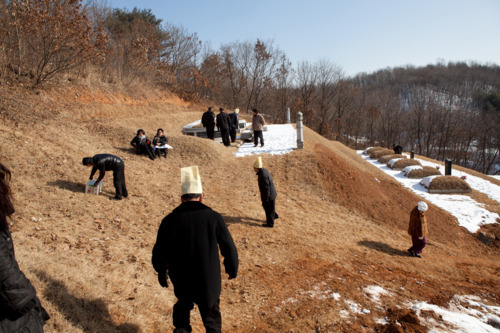
— John Stanley, Director of the Camera Club of New York
For more information on the 2011 CCNY Juried Competition, visit: { www.cameraclubny.org }
9 Sep 2011 / 2 notes / John Stanley CCNY Happenings Nathan Bett Goseong Choi Hugo Fernandes
Conveyor Magazine sighting at Cafe Grumpy in Chelsea!
8 Sep 2011 / 0 notes
Words with Pictures
Words with Pictures is a weekly two-part post that pairs photographers and writers. The first week, a writer is given a photograph to inspire the creation of a new piece of writing. The following week the photographer is given a piece of writing and responds with a new photographic piece. This series is curated by Conveyor Editor Dominica Paige.
Leif Huron and Jane Flett {Part 1}

It’s the morning after and we are standing in the kitchen like cacti on the opposite sides of an open road pelting through the desert.
Camilla’s prettier than a coconut shy, legs like a lily’s stamen. And I know I shouldn’t have, but.
We got gin-drunk at the fair. Our edges slackened like jumble-sale cardigan buttons; we giggled at the hoopla boy’s scowl.
The air was burnt popcorn promises but we grew tired of those childish songs. So we ran, our feet slapping on the parched earth like silver screen heroines furious with the infidelities of their leading men.
We left behind the one-eyed swordsman who cut his girl in two, left the bearded lady with her sad magazine-advert eyes, left the Mexican midget and his tightrope (so small a tightrope, so close to the ground.)
We reached the bales. Sat dangle-legged and picnicked on hunks of watermelon. She bit into hers and the juices dribbled down her chin and it looked sticky as the floor when
the lights come up, the music dwindles, the boys go home. And I didn’t mean to but the sun was throbbing and
I licked her.
I licked her syrup-pink candyfloss chin, softer than camisoles on skinned knees.
And before I could explain, she was gone.
/
It’s the morning after and we are standing in the kitchen like cacti and I open my lips to say I’m sorry but
there are pits in my teeth as black and patent as London cabs, so I hail one
realising it’s time
to leave.
Jane Flett lives in London where she writes stories, plays synthpunk cello solos and drinks too much gin. You can visit her at: {www.janeflett.com}
Leif Huron studied film direction and cinematography at the Academy of Film, Television and Performing Arts in Prague, CZ. His films and photographs have been featured as part of the American Photo 2008 Photos of the Year competition, Rush Arts Gallery Freeze Frame exhibition at Art Basel Miami, VUU Collective 2011 Group Show at K&K Gallery, and at Diagonale 2011 Film Festival, Graz, Austri, among others. He is currently a Candidate for MFA in Photography and Related Media at Parsons The New School for Design. Leif lives and works in Brooklyn. {www.leifhuron.com}
7 Sep 2011 / 5 notes / Words with Pictures Dominica Paige Leif Huron Jane Flett

